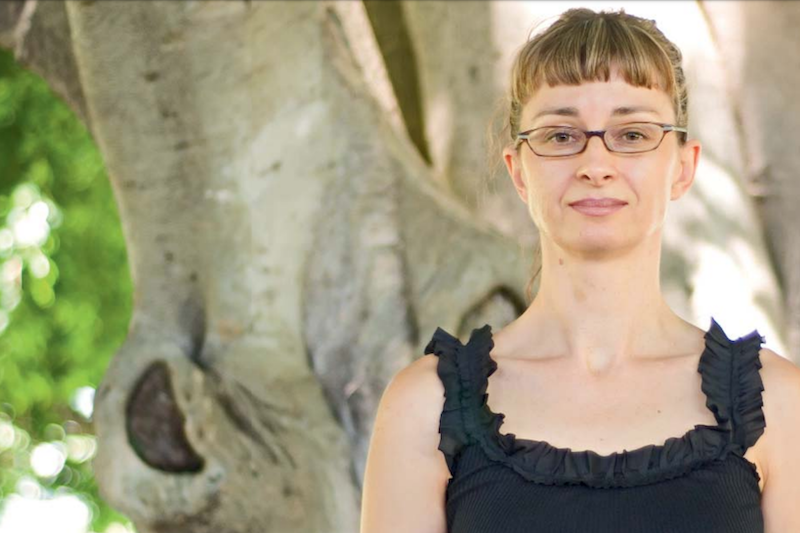Lisa Adams: Outside In
Self-taught painter Lisa Adams sits firmly outside the art establishment. Hidden away in her remote hinterland studio, she uses her distance to produce witty and often surprising takes on modern day dilemmas writes Ingrid Periz.
Words: Ingrid Periz
In Lisa Adams’s work Drift (2008), an anchor floats adrift over a swelling sea. The surprise – the weighted object held buoyant by the waves – comes quickly, we stay longer over the bigger trick Adams has performed. On her meticulously worked surface, oil paint can make the impossible real. In her forthcoming self-titled exhibition at Philip Bacon Galleries in Brisbane, Adams continues these arresting, occasionally improbable images: a hunter in plus fours takes aim at a flight of ducks, arranged overhead in a question mark; a buck stands transfixed in a woodland setting, its antlers morphed into rifles with telescopic sights; a woman strides over the desert, divining.
The self-taught Adams lives remotely on a bush property in the hinterland of Queensland’s Sunshine Coast. She is in her downstairs studio by eight in the morning and works solidly for six hours, six days a week. She produces slowly; a painting typically takes several months to complete and she will overpaint an image two or three times to get it right. For Adams, whose painting technique developed out of detailed drawing skills over a 20 year period, her lack of formal training has proved no disadvantage. As she explains, “I think it taught me self-reliance and to cope with the isolation and discipline required to be a painter.”
Adams admits she loves the painting process, saying: “It is this large amount of time spent layering and refining detail which I feel can imbue a painting with a magical quality.” Her painstaking approach begins well before she starts painting, with a very clear mental image.
“I see the painting clearly in my mind and it’s this image that I try to represent.” She works from detailed photographic references, preferring her own photos. Occasionally this involves a studio setting where Adams becomes the chief character, shot by her photographer husband Kim Guthrie. She adds: “When it proves difficult or impossible for me to access and photograph a subject, I hunt out references. I spend days trawling through electronic media archives, libraries and bookshops. I never paint from just one photograph; it sometimes takes hundreds of separate sources.”
Critics have used words like “surrealist” or “magic realist” to describe her work but neither term sits well with Adams. “I can see how both might be applied to my work,” she says diplomatically, “but am not particularly comfortable with either.” However her gently disquieting pictures might be described, it’s clear they can hold a range of audiences. Brisbane’s ultra contemporary Institute of Modern Art hosted Paintings, a solo show in 2000; in 2004 Adams’s one-person show cemented a five-year relationship with Philip Bacon Galleries. In 2008 she was included in the Queensland Gallery of Modern Art’s Optimism exhibition, with GoMA acquiring her work Rose Garden (2008) for its collection. That same year Adams’s Cold Wind (2006) won the Tattersall’s Landscape Art Prize.
When Adams first began exhibiting, she admits she was “surprised and a little disappointed that people were so preoccupied with the technical aspect of my work. Though I love the painting process I have always been motivated primarily by the idea.” Mostly, “the work is about my feelings and experience of the world. All my works are individual instalments of a self portrait.” The women featured in works like Ladder (1990-91), where a single female climbs a ladder skywards to escape a roiling nest of vipers, or Track (1999), where another woman crouches over tools, dwarfed in the landscape, or Divining, where a female water diviner wields her dowsing rod, are all stand-ins for the artist. They suggest the difficulties and determination of Adams’s approach as a resolutely representational painter in a world often inimical to the enterprise. She expands, “I don’t consider my work to be about the condition of representational painting itself but it is at times about the process and its challenge. Painting comes with its problems, but for me they are personal problems. My paintings never come easily. My style is painstaking and after years of painting all day every day I’ve come to realise the endurance required to keep going. Most people wouldn’t be aware of the physical pain that come with sitting [with a] triple zero brush in hand for years on end, or the single-minded determination to endure the isolation.” In spite of this, she adds, “I only feel excited by the possibilities painting offers.”
Lisa Adams’s next exhibition is with Philip Bacon Galleries in Brisbane from 23 June to 18 July 2009.
This article was originally published in Art Collector issue 48, APR-JUN 2008.









